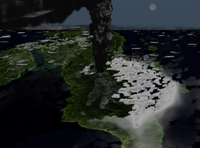
Photo from wikipedia
Arctic environments experience rapid climatic changes as air temperatures are rising and precipitation is increasing. Rivers are key elements in these regions since they drain vast land areas and thereby… Click to show full abstract
Arctic environments experience rapid climatic changes as air temperatures are rising and precipitation is increasing. Rivers are key elements in these regions since they drain vast land areas and thereby reflect various climatic signals. Zackenberg River in northeast Greenland provides a unique opportunity to study climatic influences on discharge, as the river is not connected to the Greenland ice sheet. The study aims to explain discharge patterns between 1996 and 2019 and analyse the discharge for correlations to variations in air temperature and both solid and liquid precipitation. The results reveal no trend in the annual discharge. A lengthening of the discharge period is characterised by a later freeze-up and extreme discharge peaks are observed almost yearly between 2005 and 2017. A positive correlation exists between the length of the discharge period and the Thawing Degree Days (r=0.52,p<0.01), and between the total annual discharge and the annual maximum snow depth (r=0.48,p=0.02). Thereby, snowmelt provides the main source of discharge in the first part of the runoff season. However, the influence of precipitation on discharge could not be fully identified, because of uncertainties in the data and possible delays in the hydrological system. This calls for further studies on the relationship between discharge and precipitation. The discharge patterns are also influenced by meltwater from the A.P. Olsen ice cap and an adjacent glacier-dammed lake which releases outburst floods. Hence, this mixed hydrological regime causes different relationships between the discharge and climatic trends when compared to most Arctic rivers.
Journal Title: Climate
Year Published: 2021
Link to full text (if available)
Share on Social Media: Sign Up to like & get
recommendations!